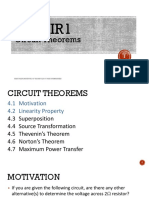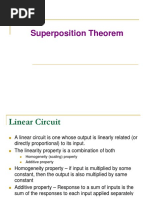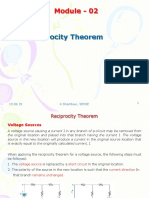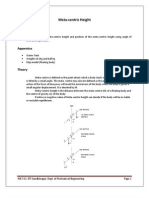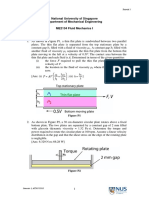Source Transformation and Super Position Theorem PDF
Uploaded by
Vasu RamSource Transformation and Super Position Theorem PDF
Uploaded by
Vasu RamModule – 02 Circuit Theorems
1. Source Transformation
2. Superposition Theorem
3. Reciprocity Theorem
4. Thevenin’s Theorem
5. Norton’s Theorem
6. Maximum Power Transfer
30.07.2018 K. Shambavi, SENSE 1
Source Transformation
• An equivalent circuit is one whose v-i characteristics are identical
with the original circuit.
• It is the process of replacing a voltage source vS in series with a
resistor R by a current source iS in parallel with a resistor R, or
vice versa.
+ +
• The arrow of the current
source is directed toward
- - the positive terminal of
(a) Independent source transform the voltage source.
+ + • The source transformation
is not possible when R = 0
for voltage source & R = ∞
for current source.
- -
(b) Dependent source transform
30.07.2018 K. Shambavi, SENSE 2
Example 1 Use source transformation to find vo in the circuit
(Or)
30.07.2018 K. Shambavi, SENSE 3
Example 2 Use source transformation to determine the current and
power absorbed by the 8- resistor.
30.07.2018 K. Shambavi, SENSE 4
Superposition Theorem
It states that the voltage across (or current through) an element in a
linear circuit is the algebraic sum of the voltage across (or currents
through) that element due to each independent source acting alone.
The principle of superposition helps us to analyze a linear circuit with
more than one independent source by calculating the contribution of
each independent source separately.
We consider the effects of 8A and 20V one by one, then add the
two effects together for final vo.
30.07.2018 K. Shambavi, SENSE 5
Superposition Theorem
Steps to apply superposition principle
1. Turn off all independent sources except one source. Find the
output (voltage or current) due to that active source using
nodal or mesh analysis.
2. Repeat step 1 for each of the other independent sources.
3. Find the total contribution by adding algebraically all the
contributions due to the independent sources.
Two things have to be kept in mind:
1. When we say turn off all other independent sources:
Independent voltage sources are replaced by 0 V (short
circuit) and
Independent current sources are replaced by 0 A (open
circuit).
2. Dependent sources are left intact because they are controlled
by circuit variables.
30.07.2018 K. Shambavi, SENSE 6
Superposition Theorem
Example 1: Use the superposition theorem to find v in the circuit shown
below.
6V is discarded
by short-circuit
3A is discarded
by open-circuit
Applying KVL to the loop
v = 10V
30.07.2018 K. Shambavi, SENSE 7
Example 2: Using the superposition theorem, find vo in the circuit
5A is discarded
by open-circuit
12V is discarded
by short-circuit
v2 = 2 x 12/10 = 2.4 V
i1 = 2.5 A v0 = v1 + v2
v1 = 2.5x2 = 5V
v0 = 5 + 2.4 = 7.4 V
30.07.2018 K. Shambavi, SENSE 8
Superposition Theorem
Example 3 Use superposition to find vx in the circuit below.
10V is discarded
by short-circuit
2A is discarded Dependant source
by open-circuit keep unchanged
Source transformation
Current to Voltage
(10 – v1)/20 +0.1 v1= v1 /4 (40 – v2)/20 +0.1 v2= v2 /4
v1= 2.5 V v2= 10 V
vx = v1+v2 = 2.5+10 V
vx = 12.5V
30.07.2018 K. Shambavi, SENSE 9
Example 4 Find io in the circuit using superposition theorem.
30.07.2018 K. Shambavi, SENSE 10
Solving , we get
30.07.2018 K. Shambavi, SENSE 11
Example 5. Use superposition to find Vo in the circuit
To find V1, we use the circuit below
Let Vo = V1 + V2, where V1 and V2
are due to 10-V and 2-A sources
30.07.2018 K. Shambavi, SENSE 12
Source transformation
To find V2
30.07.2018 K. Shambavi, SENSE 13
You might also like
- Switching Function Analysis of Power Electronic Circuits100% (3)Switching Function Analysis of Power Electronic Circuits310 pages
- : F, F, v, ρ v y, v, ∆P √Σ/ Ρl Ρv² A Ρ Qv μ √ g y ρ v²No ratings yet: F, F, v, ρ v y, v, ∆P √Σ/ Ρl Ρv² A Ρ Qv μ √ g y ρ v²2 pages
- L9_Complex Power, Linearity Property, Superposition TheoremNo ratings yetL9_Complex Power, Linearity Property, Superposition Theorem26 pages
- EEE221 2024_25 Fall Lecture Notes 5 Additional Analysis TechniquesNo ratings yetEEE221 2024_25 Fall Lecture Notes 5 Additional Analysis Techniques38 pages
- DR Hilmi Chapter 4 BDA14303 Circuit TheoremsNo ratings yetDR Hilmi Chapter 4 BDA14303 Circuit Theorems80 pages
- Chapter 4 - Circuit Theorems 2 Slides Per PageNo ratings yetChapter 4 - Circuit Theorems 2 Slides Per Page34 pages
- Experiment 6 Superposition Theorem: College of EngineeringNo ratings yetExperiment 6 Superposition Theorem: College of Engineering9 pages
- Superposition Theorem: Faculty of Engineering-Electrical and Computer Engineering DepartmentNo ratings yetSuperposition Theorem: Faculty of Engineering-Electrical and Computer Engineering Department5 pages
- Basics of Electrical Circuits: - Circuit TheoremsNo ratings yetBasics of Electrical Circuits: - Circuit Theorems39 pages
- Lesson 5 Network Laws & Theorems (Part 2)(1)No ratings yetLesson 5 Network Laws & Theorems (Part 2)(1)67 pages
- FALLSEM2023-24 BEEE102L TH VL2023240106699 2023-08-24 Reference-Material-INo ratings yetFALLSEM2023-24 BEEE102L TH VL2023240106699 2023-08-24 Reference-Material-I18 pages
- UNIT 4: Circuit Theorems: 4.0 Intended Learning OutcomesNo ratings yetUNIT 4: Circuit Theorems: 4.0 Intended Learning Outcomes29 pages
- Thevenins & Nortons Theorem and Maximum Power Transfer Theorem PDFNo ratings yetThevenins & Nortons Theorem and Maximum Power Transfer Theorem PDF13 pages
- 312312 Engineering Mechanics Msbte Manual Msbte StoreNo ratings yet312312 Engineering Mechanics Msbte Manual Msbte Store152 pages
- Piezoelectric Materials For High Power H PDFNo ratings yetPiezoelectric Materials For High Power H PDF5 pages
- Intso Stso Physics Class Viii Force & Pressure Worksheet - 20% (1)Intso Stso Physics Class Viii Force & Pressure Worksheet - 23 pages
- XLPE Land Cable Systems 2GM5007GB Rev 5No ratings yetXLPE Land Cable Systems 2GM5007GB Rev 528 pages
- documentsnull-physics+XII 6 Electromagnetic+InductionNo ratings yetdocumentsnull-physics+XII 6 Electromagnetic+Induction53 pages
- The Equations of Electromagnetism: Eda QNo ratings yetThe Equations of Electromagnetism: Eda Q22 pages
- The Analysis of The Global Ship Strengths in Vertical Plane With 3D-Fem Hull ModelsNo ratings yetThe Analysis of The Global Ship Strengths in Vertical Plane With 3D-Fem Hull Models31 pages
- Fast Fault Detection For Power Distribution SystemsNo ratings yetFast Fault Detection For Power Distribution Systems118 pages
- Advanced Rune Shamanism by Michael William DenneyNo ratings yetAdvanced Rune Shamanism by Michael William Denney102 pages
- Lecture 2: Active and Passive Circuit Elements (Resistors Only)No ratings yetLecture 2: Active and Passive Circuit Elements (Resistors Only)7 pages
- National University of Singapore Department of Mechanical Engineering ME2134 Fluid Mechanics I Tutorial 1No ratings yetNational University of Singapore Department of Mechanical Engineering ME2134 Fluid Mechanics I Tutorial 14 pages
- ME4251-Mech. Vibrations Lab MID TERM Exam S-4No ratings yetME4251-Mech. Vibrations Lab MID TERM Exam S-42 pages
- Cambridge Assessment International EducationNo ratings yetCambridge Assessment International Education12 pages
- Summer Training Report at B H E L BhopalNo ratings yetSummer Training Report at B H E L Bhopal66 pages
- Pv-Statcom: A New Smart Inverter For Voltage Control in Distribution SystemsNo ratings yetPv-Statcom: A New Smart Inverter For Voltage Control in Distribution Systems3 pages
- Switching Function Analysis of Power Electronic CircuitsSwitching Function Analysis of Power Electronic Circuits
- : F, F, v, ρ v y, v, ∆P √Σ/ Ρl Ρv² A Ρ Qv μ √ g y ρ v²: F, F, v, ρ v y, v, ∆P √Σ/ Ρl Ρv² A Ρ Qv μ √ g y ρ v²
- L9_Complex Power, Linearity Property, Superposition TheoremL9_Complex Power, Linearity Property, Superposition Theorem
- EEE221 2024_25 Fall Lecture Notes 5 Additional Analysis TechniquesEEE221 2024_25 Fall Lecture Notes 5 Additional Analysis Techniques
- Experiment 6 Superposition Theorem: College of EngineeringExperiment 6 Superposition Theorem: College of Engineering
- Superposition Theorem: Faculty of Engineering-Electrical and Computer Engineering DepartmentSuperposition Theorem: Faculty of Engineering-Electrical and Computer Engineering Department
- FALLSEM2023-24 BEEE102L TH VL2023240106699 2023-08-24 Reference-Material-IFALLSEM2023-24 BEEE102L TH VL2023240106699 2023-08-24 Reference-Material-I
- UNIT 4: Circuit Theorems: 4.0 Intended Learning OutcomesUNIT 4: Circuit Theorems: 4.0 Intended Learning Outcomes
- Thevenins & Nortons Theorem and Maximum Power Transfer Theorem PDFThevenins & Nortons Theorem and Maximum Power Transfer Theorem PDF
- 312312 Engineering Mechanics Msbte Manual Msbte Store312312 Engineering Mechanics Msbte Manual Msbte Store
- Intso Stso Physics Class Viii Force & Pressure Worksheet - 2Intso Stso Physics Class Viii Force & Pressure Worksheet - 2
- documentsnull-physics+XII 6 Electromagnetic+Inductiondocumentsnull-physics+XII 6 Electromagnetic+Induction
- The Analysis of The Global Ship Strengths in Vertical Plane With 3D-Fem Hull ModelsThe Analysis of The Global Ship Strengths in Vertical Plane With 3D-Fem Hull Models
- Fast Fault Detection For Power Distribution SystemsFast Fault Detection For Power Distribution Systems
- Lecture 2: Active and Passive Circuit Elements (Resistors Only)Lecture 2: Active and Passive Circuit Elements (Resistors Only)
- National University of Singapore Department of Mechanical Engineering ME2134 Fluid Mechanics I Tutorial 1National University of Singapore Department of Mechanical Engineering ME2134 Fluid Mechanics I Tutorial 1
- Pv-Statcom: A New Smart Inverter For Voltage Control in Distribution SystemsPv-Statcom: A New Smart Inverter For Voltage Control in Distribution Systems














